Blue Spring State Park
Blue Spring State Park is a state park located west of Orange City, Florida in the United States. The park is a popular tourist destination; available activities include canoeing, SCUBA diving, kayaking, fishing, camping, hiking, wildlife watching, and swimming. The spring in the Park (Volusia Blue Spring) is the largest on the St. Johns River. Thanks to its relatively warm temperature of 73 °F (23 °C), the spring attracts many Florida manatees during the winter months. 102 million US gallons (390,000 m3) of water flow out of Blue Spring into the St. Johns River every day.[1]
| Blue Spring State Park | |
|---|---|
IUCN category III (natural monument or feature) | |
 | |
| Location | Volusia County, Florida, United States |
| Nearest city | Orange City, Florida |
| Coordinates | 28°56′53″N 81°20′24″W |
| Governing body | Florida Department of Environmental Protection |
History
The spring was visited by botanist John Bartram in 1766.[2]
The spring and surrounding land were acquired by the Weismore family in the mid-19th century and a large plantation-style home built upon a shell mound on the property. The area seemed to be excellent for the cultivation of citrus fruit, and a small railway was built linking Orange City to the dock at Blue Spring. Ultimately, the Florida East Coast Railway was constructed not far from the present-day park. A killing freeze occurred in the 1890s, wiping out area citrus groves and driving the industry south. The Thursbys switched to the tourist trade, taking advantage of the beautiful spring and excellent fishing and hunting opportunities along the St. Johns River.
The park was acquired by the Florida Department of Environmental Protection in 1972 to kick-start its manatee protection program.
Manatee Research
Researchers have recorded the life history of individual manatees at Blue Spring since 1978, including births, deaths and relationships.[3] Manatees migrate to warmer spring water during the colder months in Florida,[4] and will often return to the same spring every year. Manatees are identified by their scar patterns, which they acquire mainly from boat strikes, but also from fishing line entanglements, cold lesions, and fungal infections.[5] The research data collected, both in person and through live video streaming,[6] comprises one of the world's longest running and comprehensive manatee databases in existence. Several government agencies partner to maintain a Manatee Individual Photo-Identification System (MIPS) for the Florida manatee.[7][5] Identifications by State Park rangers and Save the Manatee Club researchers at Blue Spring have contributed a large number of sightings to this database.
Environmental concerns
The increasing number of human visitors and also manatees has increased the environmental load on the springs ecosystem. Both humans and manatees are creating water pollution and as a result, more filamentous algae grows in the springs area.
Another environmental problem is the decrease in the natural water supply to the springs due to the groundwater pumping in the nearby cities. As a result, the output of Volusia Blue Spring has fallen over the last decades.[8]
Recreation
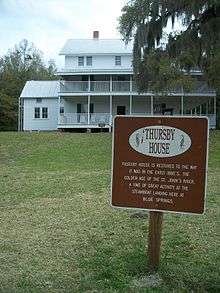
Blue Spring State Park has fifty-one campsites and six cabins that can be rented. The camping area is pet friendly.
The spring runs a few miles long and features a boardwalk which stretches 1/3 of a mile from the St. Johns River to the headspring. All water related activities are prohibited during manatee season (mid November–March).[9] Qualified Scuba divers can descend into the spring cave in season. Picnicking is a popular pastime, with multiple pavilions available for groups and scattered picnic tables around the entire park. The park also features volleyball courts and a playground, as well as, canoeing, kayaking, and fishing. The old Thursby plantation house is being maintained and has historical displays that visitors can explore. Various wildlife besides manatees can be seen as well, including alligators, bears, raccoons, and various species of birds. Hontoon Island State Park is a short paddle down the St. Johns River. Foodservice, stores, and a water activity rental station are available for supplies
See also
Wildlife gallery
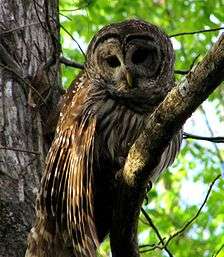
- Manatees browse beside canoe.
- Young manatee in the spring.
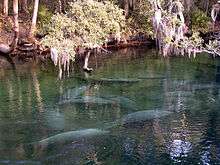 Manatees in Blue Spring State Park.
Manatees in Blue Spring State Park. Limpkin on the St. Johns River.
Limpkin on the St. Johns River.- Signs warning visitors to avoid manatee habitat.
 Wood stork near Blue Spring.
Wood stork near Blue Spring. American black vultures.
American black vultures.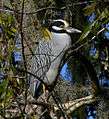
 Red-shouldered hawk, Florida sub-species.
Red-shouldered hawk, Florida sub-species. Manatee in Blue Spring.
Manatee in Blue Spring. Wood stork on the St. Johns near Blue Spring.
Wood stork on the St. Johns near Blue Spring. An alligator on the St. Johns River
An alligator on the St. Johns River- Kayaking on the Blue Spring Outlet
 Turkey vulture near the lagoon
Turkey vulture near the lagoon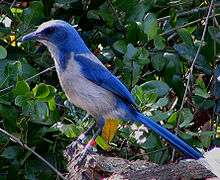 Florida scrub jay in the campground
Florida scrub jay in the campground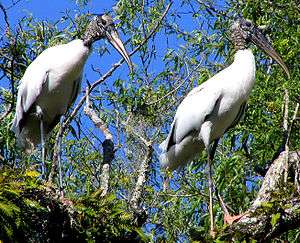 Wood storks on the Smith Canal near Blue Spring
Wood storks on the Smith Canal near Blue Spring
References
- "Volusia Blue Spring" (PDF). United States Geological Survey. Retrieved April 20, 2017.
- Florida Springs Guide: Blue Spring State Park, July 2, 2013, Orlando Sentinel
- "Manatees at Blue Spring State Park". Florida State Parks. Retrieved 2019-02-28.
- "Look out, slow down for Florida's migrating manatees". Florida Fish And Wildlife Conservation Commission. Retrieved 2019-02-28.
- "Program". Florida Fish And Wildlife Conservation Commission. Retrieved 2019-02-28.
- "Want to see manatees? Consider a trip to Blue Spring State Park this winter". UF/IFAS Extension Flagler County. 2018-01-03. Retrieved 2019-02-28.
- "Manatee Photo ID as a Tool for Research: The Manatee Individual Photo-Identification System (MIPS)". www.usgs.gov. Retrieved 2019-02-28.
- "Volusia Blue Spring Restoration Plan" (PDF). Retrieved 2019-06-25.
- "Florida State Parks". www.floridastateparks.org. Retrieved 2017-04-10.
External links
| Wikimedia Commons has media related to Blue Spring State Park. |